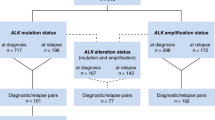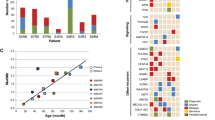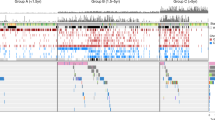Abstract
Neuroblastoma, a tumour derived from the peripheral sympathetic nervous system, is one of the most frequent solid tumours in childhood1,2. It usually occurs sporadically but familial cases are observed, with a subset of cases occurring in association with congenital malformations of the neural crest being linked to germline mutations of the PHOX2B gene1,2,3,4. Here we conducted genome-wide comparative genomic hybridization analysis on a large series of neuroblastomas. Copy number increase at the locus encoding the anaplastic lymphoma kinase (ALK)5 tyrosine kinase receptor was observed recurrently. One particularly informative case presented a high-level gene amplification that was strictly limited to ALK, indicating that this gene may contribute on its own to neuroblastoma development. Through subsequent direct sequencing of cell lines and primary tumour DNAs we identified somatic mutations of the ALK kinase domain that mainly clustered in two hotspots. Germline mutations were observed in two neuroblastoma families, indicating that ALK is a neuroblastoma predisposition gene. Mutated ALK proteins were overexpressed, hyperphosphorylated and showed constitutive kinase activity. The knockdown of ALK expression in ALK-mutated cells, but also in cell lines overexpressing a wild-type ALK, led to a marked decrease of cell proliferation. Altogether, these data identify ALK as a critical player in neuroblastoma development that may hence represent a very attractive therapeutic target in this disease that is still frequently fatal with current treatments6,7.
This is a preview of subscription content, access via your institution
Access options
Subscribe to this journal
Receive 51 print issues and online access
$199.00 per year
only $3.90 per issue
Buy this article
- Purchase on Springer Link
- Instant access to full article PDF
Prices may be subject to local taxes which are calculated during checkout


Similar content being viewed by others
Accession codes
Primary accessions
Gene Expression Omnibus
Data deposits
Microarray data have been submitted to the Gene Expression Omnibus (http://www.ncbi.nlm.nih.gov/geo) public database. The accession numbers for gene expression profiles of neuroblastoma samples and SNP data for case NB-99 displayed in Fig. 1c are GSE12460 and GSE12461, respectively.
References
Maris, J. M., Hogarty, M. D., Bagatell, R. & Cohn, S. L. Neuroblastoma. Lancet 369, 2106–2120 (2007)
Brodeur, G. M. Neuroblastoma: biological insights into a clinical enigma. Nature Rev. Cancer 3, 203–216 (2003)
Tonini, G. P., Longo, L., Coco, S. & Perri, P. Familial neuroblastoma: a complex heritable disease. Cancer Lett. 197, 41–45 (2003)
Trochet, D. et al. Germline mutations of the paired-like homeobox 2B (PHOX2B) gene in neuroblastoma. Am. J. Hum. Genet. 74, 761–764 (2004)
Chiarle, R., Voena, C., Ambrogio, C., Piva, R. & Inghirami, G. The anaplastic lymphoma kinase in the pathogenesis of cancer. Nature Rev. Cancer 8, 11–23 (2008)
Galkin, A. V. et al. Identification of NVP-TAE684, a potent, selective, and efficacious inhibitor of NPM-ALK. Proc. Natl Acad. Sci. USA 104, 270–275 (2007)
Li, R. & Morris, S. W. Development of anaplastic lymphoma (ALK) small-molecule inhibitors for cancer therapy. Med. Res. Rev. 28, 372–412 (2008)
Fix, A. et al. Characterization of amplicons in neuroblastoma. High-resolution mapping using DNA microarrays, relationship with outcome, and identification of overexpressed genes. Genes Chromosom. Cancer 47, 819–834 (2008)
Schwab, M. et al. Chromosome localization in normal human cells and neuroblastomas of a gene related to c-myc. Nature 308, 288–291 (1984)
Lamant, L. et al. Expression of the ALK tyrosine kinase gene in neuroblastoma. Am. J. Pathol. 156, 1711–1721 (2000)
Osajima-Hakomori, Y. et al. Biological role of anaplastic lymphoma kinase in neuroblastoma. Am. J. Pathol. 167, 213–222 (2005)
Miyake, I. et al. Activation of anaplastic lymphoma kinase is responsible for hyperphosphorylation of ShcC in neuroblastoma cell lines. Oncogene 21, 5823–5834 (2002)
Blume-Jensen, P. & Hunter, T. Oncogenic kinase signalling. Nature 411, 355–365 (2001)
Rikova, K. et al. Global survey of phosphotyrosine signaling identifies oncogenic kinases in lung cancer. Cell 131, 1190–1203 (2007)
Zou, H. Y. et al. An orally available small-molecule inhibitor of c-Met, PF-2341066, exhibits cytoreductive antitumor efficacy through antiproliferative and antiangiogenic mechanisms. Cancer Res. 67, 4408–4417 (2007)
McDermott, U. et al. Genomic alterations of anaplastic lymphoma kinase may sensitize tumors to anaplastic lymphoma kinase inhibitors. Cancer Res. 68, 3389–3395 (2008)
Morris, S. W. et al. Fusion of a kinase gene, ALK, to a nucleolar protein gene, NPM, in non-Hodgkin’s lymphoma. Science 263, 1281–1284 (1994)
Griffin, C. A. et al. Recurrent involvement of 2p23 in inflammatory myofibroblastic tumors. Cancer Res. 59, 2276–2280 (1999)
Soda, M. et al. Identification of the transforming EML4-ALK fusion gene in non-small-cell lung cancer. Nature 448, 561–566 (2007)
Chiarle, R. et al. NPM-ALK transgenic mice spontaneously develop T-cell lymphomas and plasma cell tumors. Blood 101, 1919–1927 (2003)
Fujimoto, J. et al. Characterization of the transforming activity of p80, a hyperphosphorylated protein in a Ki-1 lymphoma cell line with chromosomal translocation t(2;5). Proc. Natl Acad. Sci. USA 93, 4181–4186 (1996)
Hubbard, S. R. Juxtamembrane autoinhibition in receptor tyrosine kinase. Nature Rev. Mol. Cell Biol. 5, 464–471 (2004)
Renneville, A. et al. Cooperating gene mutations in acute myeloid leukaemia: a review of the literature. Leukemia 22, 915–931 (2008)
Gilliland, G. & Griffin, G. The roles of FLT3 in hematopoiesis and leukaemia. Blood 100, 1532–1542 (2002)
Fröhling, S. et al. Identification of driver and passenger mutations of FLT3 by high-throughput DNA sequence analysis and functional assessment of candidate alleles. Cancer Cell 12, 501–513 (2007)
Chiarle, R. et al. The anaplastic lymphoma kinase is an effective oncoantigen for lymphoma vaccination. Nature. Med. 14, 676–680 (2008)
Vincent-Salomon, A., Raynal, V., Lucchesi, C., Gruel, N. & Delattre, O. ESR1 gene amplification in breast cancer: a common phenomenon? Nature Genet. 40, 809 (2008)
Acknowledgements
We are grateful to F. Moreau-Gachelin, I. Gallais, D. Surdez, F. Tirode, A. Fix, F. Bourdeaut, A. Almeida, C. Lucchesi, S. Roman Roman, B. Bressac, J. Bénard and G. Vassal for their critical help. We thank C. Decraene, D. Gentien and B. Albaud from the translational department of Institut Curie for profiling the paediatric tumours, and P. Rosa and E. Barillot for the development of bioinformatic tools. We thank M. Lathrop and the Centre National de Génotypage for the Affymetrix 100K SNP analysis and A. Chompret for collecting families. This work was supported by grants from the Agence Nationale pour la Recherche, the Institut National du Cancer, the Ligue Nationale contre le Cancer (Equipe labellisée and CIT project), the APAESIC (Association des Parents et des Amis des Enfants Soignés à l’Institut Curie), the Association Hubert Gouin, les amis de Claire, Les Bagouz à Manon and Enfance et Santé. A.P. and V.C. are supported by the Comité de l'Ain of the Ligue Nationale contre le Cancer.
Author Contributions I.J.-L., D.L., A.R., L.P., V.C. and V.R. generated the data; I.J.-L., G.P., A.P., J.M., J.A., S.L. and O.D. made the study design and follow-up; L.B., V.C., A.P., G.S., D.V.-C., T.F., S.L. and J.A. contributed biological materials that were used in this study.
Author information
Authors and Affiliations
Corresponding author
Supplementary information
Supplementary Information
This file contains Supplementary Figures 1 and 2 with Legends. (PDF 111 kb)
PowerPoint slides
Rights and permissions
About this article
Cite this article
Janoueix-Lerosey, I., Lequin, D., Brugières, L. et al. Somatic and germline activating mutations of the ALK kinase receptor in neuroblastoma. Nature 455, 967–970 (2008). https://doi.org/10.1038/nature07398
Received:
Accepted:
Issue Date:
DOI: https://doi.org/10.1038/nature07398
This article is cited by
-
Comprehensive exploration of the involvement of cuproptosis in tumorigenesis and progression of neuroblastoma
BMC Genomics (2023)
-
ALK fusions in the pan-cancer setting: another tumor-agnostic target?
npj Precision Oncology (2023)
-
Targeting TRIM24 promotes neuroblastoma differentiation and decreases tumorigenicity via LSD1/CoREST complex
Cellular Oncology (2023)
-
Genomic ALK alterations in primary and relapsed neuroblastoma
British Journal of Cancer (2023)
-
Circulating tumor DNA reveals mechanisms of lorlatinib resistance in patients with relapsed/refractory ALK-driven neuroblastoma
Nature Communications (2023)
Comments
By submitting a comment you agree to abide by our Terms and Community Guidelines. If you find something abusive or that does not comply with our terms or guidelines please flag it as inappropriate.



